Since we didn't get a chance to update her progress yesterday, I'll give you a short one now and later tonight I'll let her mom recap it. Remember this is in my words (not the doctor's or her mom's).
My little girl is doing wonderful!!! As we speak (or at least me, since your not really speaking, your just reading) she is getting some kind of excabation. OK, I don't know what the word is or even how to pronounce it, but what it means is she is having the tube that's in her mouth removed. If she does OK on her own then that's one less hurdle to deal with. If she doesn't do OK then they will have to put it back in and try again in a couple days.
So that's the update in my words. It won't be long now before we can come home as a family.
By the way, Bray is sleeping next to me right now and he is snoring. But I don't mind because he's here with us.
Sunday, October 14, 2007
Subscribe to:
Post Comments (Atom)
Ava with Mommy & Daddy
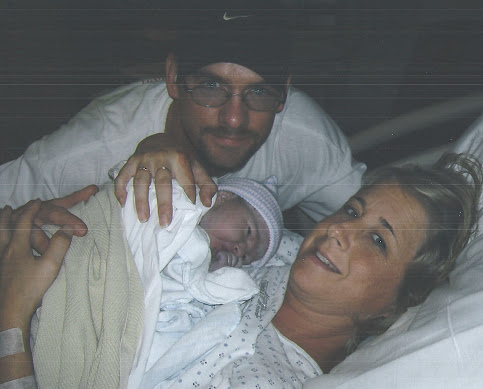
Isn't she beautiful!
It's A Girl!
Hello everyone and welcome to Ava Christine's Blog.
First a little info about the new edition to our family.
This beautiful little girl comes to our family after many years of trying on her parents part as well as her being the first girl in 19 years. Yes 19 years! So to say that she is going to be a little spoiled is putting it very lightly.
Ava Christine was welcomed into this world on September 29 2007 by her mommy Jamie, Daddy Jamie, big brother Brayden, grandparents, aunts, uncles, cousins, and numerous friends. Shortly after Ava's arrival the wonderful medical staff at Memorial hospital of South Bend found what they called a murmur in Ava's heart. After some testing little Ava was transported to Motts' Children Hospital at the University of Michigan in Ann Arbor. Jamie and Jamie were informed that little Ava has a heart defect that could be life threatening and that she needed to undergo open heart surgery to fix the defects. So, on Tuesday October 2 2007 Ava was operated on by the wonderful medical staff at the U of M. What this team of doctors did to Ava is incredible. First of all Jamie explained to me over the phone today just what problems Ava's heart has endured. Ava's heart has a couple of different problems. The first is known as Interrupted Aortic Arch. The following info about interrupted aortic arch is best explained by the U of M Cardiac website, "Interrupted aortic arch is a very rare heart defect that occurs when the aorta does not develop normally while the baby is in the mother’s womb. It comprises about 1% of all congenital heart defects. It usually occurs along with other heart problems such as truncus arteriosus, ventricular septal defect, transposition of the great arteries, and aortic stenosis.The aorta is the large blood vessel that arises from the left side of the normal heart and takes red blood out to the body. The first part of the aorta, called the ascending aorta (1) arises upwards. It then curves leftward forming the aortic arch (2). The aorta then curves downward towards the lower body, and this part is called the descending aorta (3). Three blood vessels exit from the aortic arch and supply the head and arms with red blood. These vessels are called the innominate artery (4), the left carotid artery (5), and the left subclavian artery (6).In babies with interrupted aortic arch, there is a complete blockage between the ascending and the descending aorta (1). This means that there is no direct way for red blood leaving the heart to reach the body parts that are "downstream" from the blockage. The site of the defect varies (2) and may or may not involve the take-off of the head and neck vessels. In most babies with interrupted aortic arch (70-90%) there is also a large ventricular septal defect (3).In newborns with interrupted aortic arch, the only way for blood to bypass the blockage is via the patent ductus arteriosus (4). Prior to birth, this small blood vessel permits blood to by-pass the baby’s fluid-filled lungs. One or two days after birth, this vessel usually closes on its own. In a baby with interrupted aortic arch, if the duct closes, blood can no longer reach the lower body. This can cause the baby to suddenly become very ill. Therefore, after the diagnosis is made, a medicine called prostaglandin is used to keep the ductus arteriosus open until surgery". (http://www.med.umich.edu/cvc/mchc/parint.htm)
So how did the doctors fix this? "Interrupted aortic arch is a serious heart defect that requires surgery soon after birth. The goal of surgery is to create remove the blockage. This used to be done in a two-stage operation but is now done most of the time in one stage. The two ends of the aorta are sewn together (1) and the patent ductus arterious (2) is tied off. Sometimes a patch is needed to reinforce the repair. If present, a patch is sewn over the VSD (3)". (http://www.med.umich.edu/cvc/mchc/parint.htm)
In #1 of the picture below is the part of Ava' heart that was repaired.
First a little info about the new edition to our family.
This beautiful little girl comes to our family after many years of trying on her parents part as well as her being the first girl in 19 years. Yes 19 years! So to say that she is going to be a little spoiled is putting it very lightly.
Ava Christine was welcomed into this world on September 29 2007 by her mommy Jamie, Daddy Jamie, big brother Brayden, grandparents, aunts, uncles, cousins, and numerous friends. Shortly after Ava's arrival the wonderful medical staff at Memorial hospital of South Bend found what they called a murmur in Ava's heart. After some testing little Ava was transported to Motts' Children Hospital at the University of Michigan in Ann Arbor. Jamie and Jamie were informed that little Ava has a heart defect that could be life threatening and that she needed to undergo open heart surgery to fix the defects. So, on Tuesday October 2 2007 Ava was operated on by the wonderful medical staff at the U of M. What this team of doctors did to Ava is incredible. First of all Jamie explained to me over the phone today just what problems Ava's heart has endured. Ava's heart has a couple of different problems. The first is known as Interrupted Aortic Arch. The following info about interrupted aortic arch is best explained by the U of M Cardiac website, "Interrupted aortic arch is a very rare heart defect that occurs when the aorta does not develop normally while the baby is in the mother’s womb. It comprises about 1% of all congenital heart defects. It usually occurs along with other heart problems such as truncus arteriosus, ventricular septal defect, transposition of the great arteries, and aortic stenosis.The aorta is the large blood vessel that arises from the left side of the normal heart and takes red blood out to the body. The first part of the aorta, called the ascending aorta (1) arises upwards. It then curves leftward forming the aortic arch (2). The aorta then curves downward towards the lower body, and this part is called the descending aorta (3). Three blood vessels exit from the aortic arch and supply the head and arms with red blood. These vessels are called the innominate artery (4), the left carotid artery (5), and the left subclavian artery (6).In babies with interrupted aortic arch, there is a complete blockage between the ascending and the descending aorta (1). This means that there is no direct way for red blood leaving the heart to reach the body parts that are "downstream" from the blockage. The site of the defect varies (2) and may or may not involve the take-off of the head and neck vessels. In most babies with interrupted aortic arch (70-90%) there is also a large ventricular septal defect (3).In newborns with interrupted aortic arch, the only way for blood to bypass the blockage is via the patent ductus arteriosus (4). Prior to birth, this small blood vessel permits blood to by-pass the baby’s fluid-filled lungs. One or two days after birth, this vessel usually closes on its own. In a baby with interrupted aortic arch, if the duct closes, blood can no longer reach the lower body. This can cause the baby to suddenly become very ill. Therefore, after the diagnosis is made, a medicine called prostaglandin is used to keep the ductus arteriosus open until surgery". (http://www.med.umich.edu/cvc/mchc/parint.htm)
So how did the doctors fix this? "Interrupted aortic arch is a serious heart defect that requires surgery soon after birth. The goal of surgery is to create remove the blockage. This used to be done in a two-stage operation but is now done most of the time in one stage. The two ends of the aorta are sewn together (1) and the patent ductus arterious (2) is tied off. Sometimes a patch is needed to reinforce the repair. If present, a patch is sewn over the VSD (3)". (http://www.med.umich.edu/cvc/mchc/parint.htm)
In #1 of the picture below is the part of Ava' heart that was repaired.
Before surgery
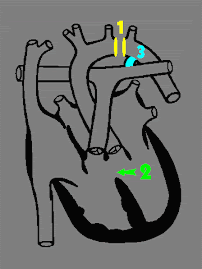
The Next Step
The next step in repairing Ava's heart was to fix what is known as Truncus Arteriosus. Truncus arteriosus is "characterized by a large ventricular septal defect over which a large, single great vessel (truncus) arises. This single great vessel carries blood both to the body and to the lungs". (http://www.americanheart.org/presenter.jhtml?identifier=11073) Below is a picture of what Ava's heart was like before surgery.
Before Surgery

After Surgery

The above picture shows what the surgeon did to repair Ava's heart. "Surgery is required to close the ventricular septal defect and separate blood flow to the body from blood flow to the lungs. This is generally done early in infancy to prevent high blood pressure from damaging the lungs' arteries. A patch is used to close the ventricular defect. The pulmonary arteries are then disconnected from the single great vessel and a tube (a conduit or tunnel) is placed from the right ventricle to these pulmonary arteries. This is sometimes called a Rastelli repair". (http://www.americanheart.org/presenter.jhtml?identifier=11073)
Blog Archive
-
▼
2007
(67)
-
▼
October
(28)
- Turning a corner?
- Holding Tight!
- Extubated Again!
- Happy Birthday Ava!
- Quick Update
- sick day at Ronald McDonald's
- Life's Rainbows
- One Step Forward, Two Steps Back
- U-Turn on I94
- Last post from me
- Even More to Overcome!
- The End of C-PAP - Coming Soon???
- Cherishing Every Moment!
- In Her Own Good Time!
- Short and Sweet
- Another message from me
- Ava's on Viagra! What?
- A lot to be thankful for
- Ava's update
- Brayden's note to Ava
- MRI Results
- A different note
- Another Day of Progress for Ava!
- Courage is not always big and loud, sometimes it's...
- More to the roller coaster ride!
- Big Brother Brayden
- UPDATE.....Ava is slowly getting better!
- Trying to keep this up to date
-
▼
October
(28)





























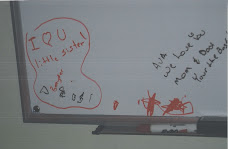

















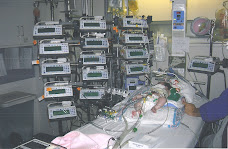
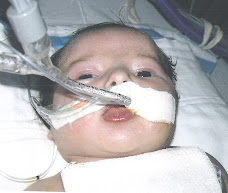






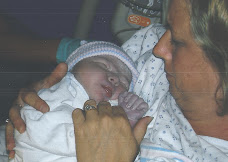
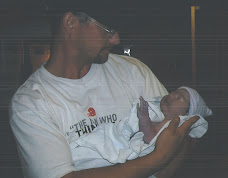

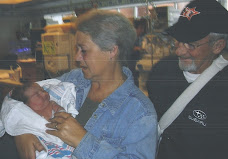

1 comment:
Oh my gosh....daddy Z, you are so darn cute!
Post a Comment